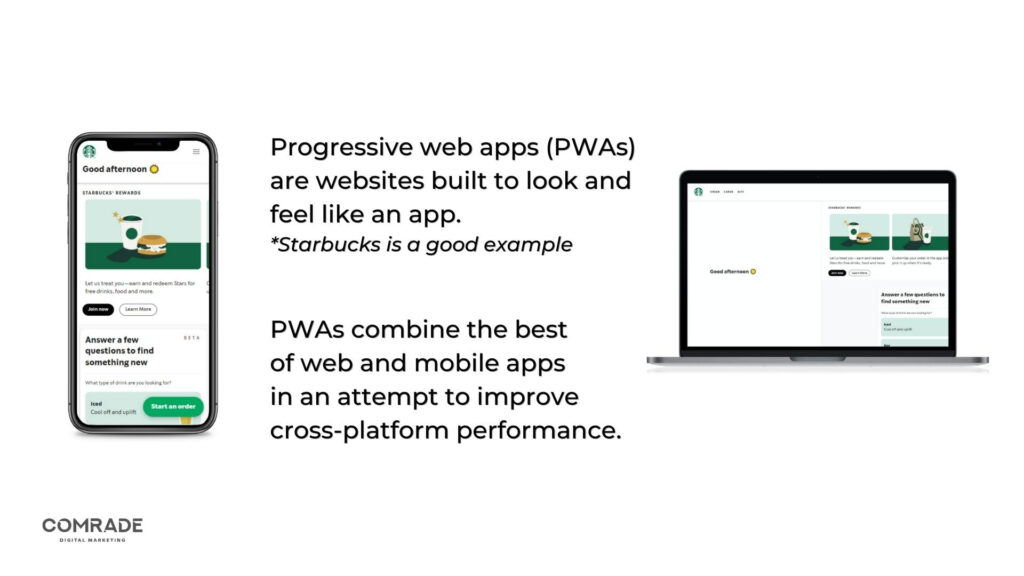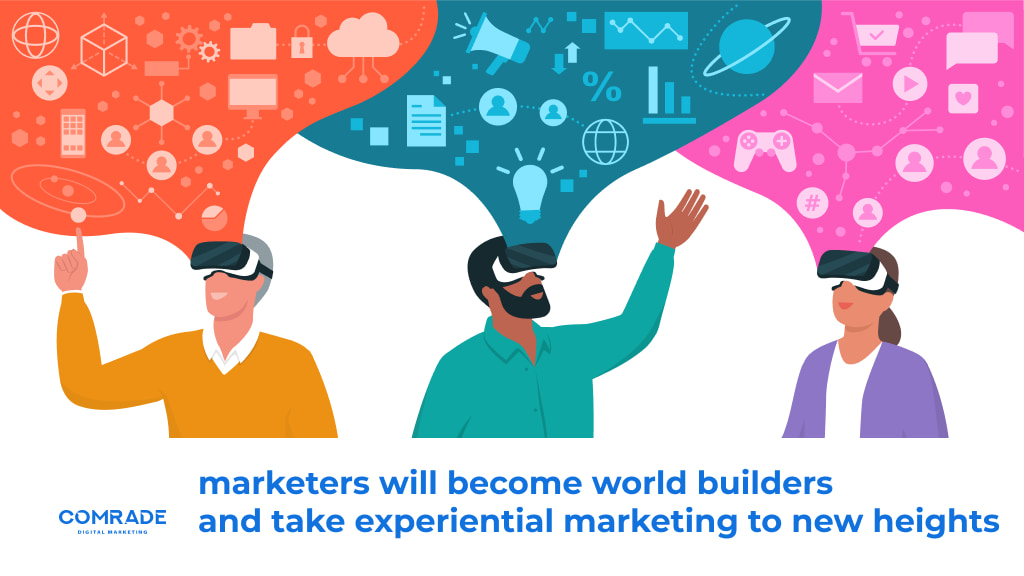Brands are walking a tightrope between capturing the attention of wary internet users emerging from an unprecedented pandemic and keeping up with technological advancements. Below are the dominant advertisement trends and key strategies for 2024 to help your business retain its competitive advantage in a fast-changing world.
1. Shorts, TikTok and Twitter Video
One of the biggest digital marketing trends is video. 86% percent of marketers say online video ads are highly effective in lead generation, making the visual medium an indispensable marketing tool supporting current marketing efforts.
Different social media channels’ built-in video creation capabilities provide a low entry bar for marketers of all experience levels. Hence, you can advertise without having to find large sums of cash for ad spend.
Even without a qualified production team, there are many video marketing tips you can learn from YouTube.
Interestingly, 85% of short videos viewed on Facebook are watched without sound. Facebook, Instagram, TikTok, and YouTube offer audio transcription features to provide a user-friendly experience.
This makes sense, as people on the go or in public environments won’t listen to the sound.
You can expect companies to embrace top digital marketing trends like having a more authentic approach to social media marketing that prioritizes video. Other digital advertising trends indicate leveraging user-generated content to engage, educate, and inspire consumers are also on the rise.
Regardless of the social media platform, there are key video strategies you can use to build your brand strategy and reach your audience, like:
- Interview videos
- Brand story videos
- Behind-the-scenes content
- Tutorials
- Product videos

You also don’t have to produce long-form videos. Sticking to short Instagram Reels or TikTok video length content allows you to test and play with various formats and styles.
And, if you’re experimenting with video advertising trends in general and video on Twitter in particular, you should know that promoted tweets save 50% on cost-per-engagement, so it’s worthwhile investing in ad spending.
2. Data Privacy and Security
Privacy regulations and compliance obligations will continue to expand and tighten. Marketers face a paradox: Consumers want targeted advertising, yet they are concerned about providing the data marketers need to create those very experiences.
Brands that get customer privacy and safety right will disrupt the market and cultivate stronger customer relationships.
Some marketing professionals counter privacy issues by switching to what we call gated offers. Instead of relying on specific individuals to opt-in on generic data sharing, brands are requesting specific data collection in exchange for something of value like discounted offers.
This type of transparent offer puts approval in the hands of the customer. Firms that consistently cultivate trust with customers and explain how their data is used in common-sense terms will be better equipped to navigate more stringent data and security laws as they arise.
At the time of writing, the U.S. doesn’t have a singular law that covers the privacy of all types of data. Companies abide by a mix of laws with the acronyms HIPAA, FCRA, FERPA, GLBA, ECPA, COPPA, and VPPA.
3. Progressive Web Apps
Progressive web apps (PWAs) are websites built to look and feel like an app. BMW and Starbucks are good examples. Originally proposed by Google in 2015, PWAs combine the best of web and mobile apps in an attempt to improve cross-platform performance.
A study by MindSea found that 50% of U.S. smartphone users download zero mobile apps per month, yet over 60% of people search online using their mobiles. PWAs truly provide an effective middle ground.
In theory, these apps should deliver a uniform and seamless experience that’s identical to a native mobile device app. They offer speed, the ability to work offline, and accessibility directly from the browser. Users can add them to their mobiles’ Home Screen, just like an app, except they take up far less storage space.
Progressive web apps are also cost-effective. Developers only have to keep track of a single code base to build a progressive app, minimizing overall development time. Unlike native apps, they also don’t depend on a specific operating system or installation, which offers a wider audience reach.
Additionally, almost 60% of consumers allow PWAs to send push notifications, which significantly increases opportunities to promote products and services. These are displayed on the screens of mobile devices, offering increased engagement in comparison to Google ads, blog posts, or email marketing campaigns.

4. Ecommerce on Social Media Platforms
Traditionally, social media networks were places where users window shopped, and search engines were where real purchases took place. This is no longer the case. Social media has become the global mall of the 21st century where users both hang out and shop.
Facebook, TikTok, and Instagram are prime examples of this key trend. The main benefit of this phenomenon is that it reduces friction within the sales funnel by allowing users to discover a product and buy it within one app.
Mobile commerce isn’t a competitor to traditional e-commerce, but rather an extension of it on social media platforms. Unsurprisingly, it is the top choice for conducting brand research for Gen Z consumers aged 16 to 24.
Successful social commerce marketing strategies should curate shoppable content and online ads across social platforms that encourage customers to shop directly in-feed.
B2C brands with new and differentiated products and aspirational imagery tend to have the largest growth in retail sales. According to eMarketer, U.S. social eCommerce skyrocketed by 38% to $26.77 billion and is expected to surpass $50 billion annually by 2024.
5. Continued Content Segmentation
When brands decide to use content marketing strategies like email, for instance, to promote or sell their products or services, they frequently give their audience the choice to opt-in or opt-out. Which they choose is primarily dependent on their audience and the types of digital ads adopted.
But this digital marketing trend turned strategy extends across marketing channels. Think about the times you’ve signed up for brand communication. They might provide the option to contact you via SMS or email, and every so often, they even ask about the types of content you prefer, i.e., discounts or new product launches.
When you empower consumers with choice, you develop trust and grow positive relationships. You also make it easier to segment your current customer base.
Remember, content segmentation can be demographic, firmographic, psychographic, and behavioral.
At present, content optimization, along with hyper-personalized online content segmentation, is all the rage because it creates customized customer journeys in real-time (see below: Omnimarketing).
The main goal is to treat each online shopping prospect as an individual, sending them personalized and relevant online advertising.
This granular content segmentation utilizes complex data like:
- A customer’s browsing activity and search history
- Purchasing behavior
- Active buying times
- Notifications responded to
Of course, these activities should always meet data and security compliance. Most marketing companies use artificial intelligence tools with machine learning capabilities to help gather important data and tailor relevant marketing messages.

6. Conversational Marketing
A customer-centric and dialogue-driven marketing approach, known as conversational marketing, has become a dominant strategy to drive customer engagement and increase sales over the last five years.
Instead of forcing target customers to go through a lead capture form or wait for days to receive an email response, conversational marketing uses intelligent chatbots to take care of customer service on your website.
According to Harvard Business Review, companies that don’t respond within five minutes of initial contact decrease their chances of qualifying leads by 400%.
Drift.com, Inc., describes the conversational marketing process as follows:
- When a user lands on a website, a chat box appears with qualifying questions.
- After the user selects a question, the bot will initiate a conversation to understand the users’ query and recommend the next steps.
This simple process speeds up response time and ensures clients chat with the right reps. Not only does this humanize brands, but it also shortens the sales cycle, grows the sales pipeline, and adds roughly 15% more leads to the top of the funnel.
7. Artificial Intelligence in Digital Marketing Trends
We’ve already touched upon AI digital marketing trends like chatbots to nurture customer engagement. Regarding AI, trends in online advertising also indicate a rise in voice search and augmented reality on digital platforms.

Voice Search
Mobile-first is the way to go as more and more consumers are switching to hands-free data inputs while on the move. It’s already predicted that over 50% of all searches are voice-based. Hence, it remains a driving factor of local SEO.
Search engine optimization for voice search is slightly different from traditional SEO. When speaking, we tend to use longer sentences, which suit long-tail keywords.
For example, it’s the difference between typing “weather Boston Sunday” into a search engine versus asking, “what is the weather like in Boston on Sunday?”
Brands keen to implement this as part of their marketing plan should consider including fuller sentences with targeted keywords, as well as adding phrases in headers to match the queries of relevant keyword sequences in Google search.
Augmented Reality
While widely contested, 2021 saw gaming as the second most prominent area of NFT development where players could win in-game assets. The launch of the Metaverse has solidified the future of blockchain and how digital technology will interpolate our lives.
For instance, Dolce & Gabbana released “Collezione Genesi,” an AR wearables NFT collection that netted almost $6 million where some items were physical but came with a virtual counterpart, and others were solely created in the digital space.
Ikea’s Place App is another example of virtual reality and augmented reality success. It allows customers to try furniture in their homes before purchasing. Brands like Kylie Cosmetics, Nike, and even Coca-Cola have developed custom Instagram filters to drive engagement on social media platforms.
In short: Augmented reality delivers memorable customer experiences. In some cases, like Ikea, it allows customers to test products before purchasing, changing the marketing and sales game.
Expanded Social Universe
Relatively new-ish apps like Discord and Clubhouse have expanded the social universe, not to mention the Metaverse, which offers exponential marketing opportunities. What is most interesting about the metaverse is how marketers will become world builders and take experiential marketing to new heights.
With this is the advent of new consumer behaviors, including the establishment of new currencies and economics, i.e., non-fungible tokens (NFTS) to exchange foods. While it’s still new, it is part of the future and shouldn’t be neglected.
The skateboarding brand Vans recently launched a virtual skate park in the Metaverse that allowed players to earn points for trying new tricks, which they could redeem in the virtual store to customize their avatar. To date, the park has seen more than 48 million visitors. This gives you an idea of the types of ad campaigns and their potential reach in the metaverse.

8. Omnimarketing
Multichannel marketing focuses on engaging customers, whereas omnichannel marketing focuses on improving customer experience. Omnichannel marketing uses both physical and digital storefronts to create a unified, seamless brand experience for consumers on any platform, at any time.
For instance, your target audience will likely bounce across your marketing channels, perhaps starting on your Instagram page before heading to your store and then maybe viewing your website.
When this digital marketing strategy is done effectively, it lets consumers move freely to the next touchpoint, building a relationship improves the overall customer experience and develops brand loyalty. With this comes multichannel attribution and the deployment of cross-channel analytics.
The main benefits of this digital marketing strategy are high retention and customer loyalty, a smoother customer journey, and instant revenue growth.
Examples of omnichannel marketing might look like this:
- Pre-ordering take away coffee, so you can collect it once you arrive at the shop
- Checking if a retail store has a stock of the item you want before visiting
- Virtually trying on clothing before purchasing in-person
Digital marketers utilizing omnichannel marketing focus on the brand, not the channel. If you’re just starting out, select up to three channels where target audiences spend the most time and focus on a specific campaign over a defined period of time.

Develop a Professional Marketing Strategy
Online advertising trends offer new opportunities for business innovation and growth. The digital marketing trends of 2024 point to increased personalization. Audiences are growing more particular about what they want, and technology is helping brands deliver content and experiences across advertising platforms that consumers want to see.
Even if digital marketing is a relatively new concept to you, it’s become increasingly important to every businesses’ bottom line. A company without an online presence or digital advertising strategy will undoubtedly not gain its share of the market. Comrade Digital Marketing Agency has over a decade experience and has been rated in tops of marketing & advertising companies, if you need help with your digital marketing, chat with us. We’ll help you implement key ad trends that deliver results!
Frequently Asked Questions
In what cities do you work?
Comrade originates in Chicago, but we worked all around the United States. We can help your business grow and increase revenue whenever you are. We have offices across most major cities in the US. For example, we can offer digital marketing services in Chicago or San Antonio. You can even find our internet marketing experts in Portland! If you want to know more about our Kansas City digital marketing agency or find out how exactly we can help you, contact us via the phone or email.


